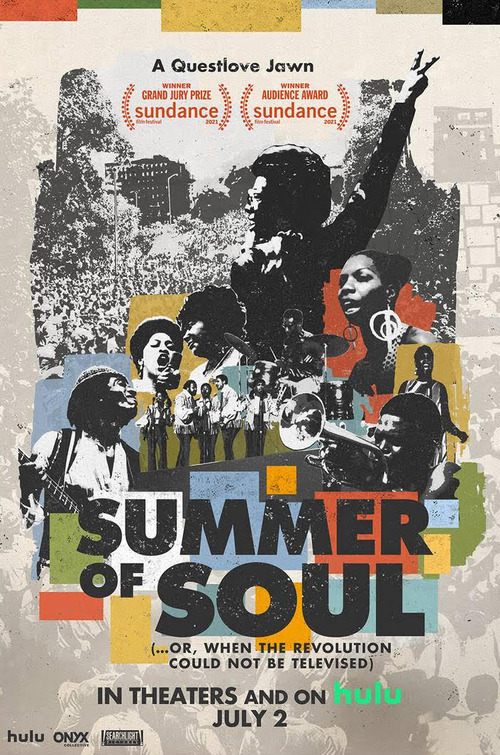
Everyone’s heard of Woodstock. It has pretty much become THE symbol of the counterculture movement of the 1960s. The 3-day music festival was held August 15–18 in 1969. Its mystic significance has only grown since. Half a century later, the influential touchstone is still a historical benchmark of popular music as well as a defining moment for a generation. Michael Wadleigh’s landmark 1970 documentary cemented its status as a phenomenon.
There was another music celebration in New York that year. 100 miles away from Bethel, the Harlem Cultural Festival started earlier that summer. From June 29 to Aug. 24 on each Sunday at 3 PM in the afternoon, a concert took place in Mount Morris Park (renamed Marcus Garvey Park in 1973). The event was hosted and promoted by Tony Lawrence, a genial and charismatic nightclub singer. The stated purpose was to celebrate African American culture. Promoting the ongoing politics of black pride was also a motivation.
A jaw-dropping assemblage of talent showed up. The 5th Dimension, Sly, and the Family Stone. Stevie Wonder, The Staple Singers, Nina Simone, BB King, and Mahalia Jackson all took the stage at different points. Gladys Knight and the Pips also appeared. Would you believe they weren’t even considered headliners at that point? Despite the fact that their recording of “I Heard It Through the Grapevine” had been a massive hit in 1967, their legendary reputation had not been established. Gladys Knight’s performance is among my favorites and the Pips choreography is nothing less than sensational.
The actual event presented in the Summer of Soul (…Or, When the Revolution Could Not Be Televised) was by all accounts a success. The series of six free shows boasted a combined attendance of nearly 300,000. Then it faded from memory. TV producer Hal Tulchin filmed the exhibition on 50 reels of tape which comprised 40 hours of live footage. He tried to get somebody — anybody — interested in his document. New York’s WNEW-TV Channel 5 (now FOX 5) broadcast hour-long specials at the time but that too failed to cause much of a stir. Later Tulchin tried dubbing this as the “Black Woodstock” to generate interest. It didn’t. For the better part of 50 years, Tulchin’s film was stored away in his basement in Bronxville and largely forgotten — until now. Sadly Tulchin, who died in 2017, is not around to see its resurgence.
Ahmir “Questlove” Thompson was shocked to discover this occurred in the summer of ’69. As the musical director for The Tonight Show and the drummer for the hip hop band the Roots, he’s a knowledgeable individual. Like the majority of us, Questlove was completely unaware of its existence. Summer of Soul (…or, When the Revolution Could Not Be Televised) becomes a riveting capsule of history. In between clips, we are treated to interviews with assorted people providing historical context and comment. Some of it is a bit redundant as it hammers away at a predetermined social narrative. Its virtue is abundantly clear simply from the visual spectacle and unvarnished facts. Nevertheless, the observations are deeply fascinating. Others are amusing. Festival attendee Musa Jackson was there when he was four with his family. “It smelled like Afro Sheen and chicken” he fondly recalls. “It was the ultimate Black barbecue.”
One of the best things Questlove does is filming the artists today watching their appearances back then. Getting founding members Billy Davis Jr. and Marilyn McCoo of the 5th Dimension to comment is a deeply emotional experience for them as well as the audience. They apparently are witnessing the footage simultaneously for the first time as us. The group’s lush, meticulously crafted version of “champagne soul” straddled the line between various genres. They openly discuss their concerns at the time.
Many intriguing tidbits are revealed. Contrary to some reports, the NYPD did indeed provide security. You can clearly see them at various points throughout the crowd. They kind of stick out. However, for the June 29 date featuring Sly and the Family Stone, they did refuse and it was instead provided by members of the Black Panther Party. The 3rd show literally occurred on the very same day as the Moon landing. Illuminating interviews of the attendees provide their frank and cogent opinions on the relevance of that cultural milestone versus this one.
So many wonderful highlights. Its difficult for me to convey the passion of an actual performance. When elder gospel legend Mahalia Jackson invites protege Mavis Staples to sing, it’s certainly one of the film’s most powerful moments. The torch-passing spectacle of “Take My Hand, Precious Lord” was a favorite of Rev. Martin Luther King Jr. The civil rights leader had been assassinated one year earlier. Another inclusion that shows how much things have changed: New York City mayor John Lindsay — a white Republican — is warmly embraced by the crowd. He takes the stage in a mutual support of the community.
Now that it has been unearthed, it will be interesting to see the effect this long-forgotten document of history has on future generations. It already won both the Grand Jury Prize and Audience Award at the 2021 Sundance Film Festival. Critical acclaim has been ubiquitous. Thanks to Questlove’s influence, he was able to secure and edit this testimony. It is an impressive directorial debut. Finally, the revolution CAN be televised….for the first time in over 50 years.
07-02-21


4 Responses
Very good write up. I completely agree with you. One of my favorites of 2021
Thank you! I really spent a lot of time on my thoughts. I also responded very positively to this movie. It’s a highlight of 2021. 😊
Very well written. I couldn’t agree with you more, Questlove did a great job on this. If I was a performer then, and saw this for the first time, I would have gotten choked up.
It’s such a time capsule. This isn’t the first time a little known event is rediscovered but it still surprises me.